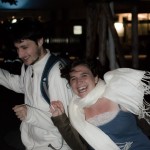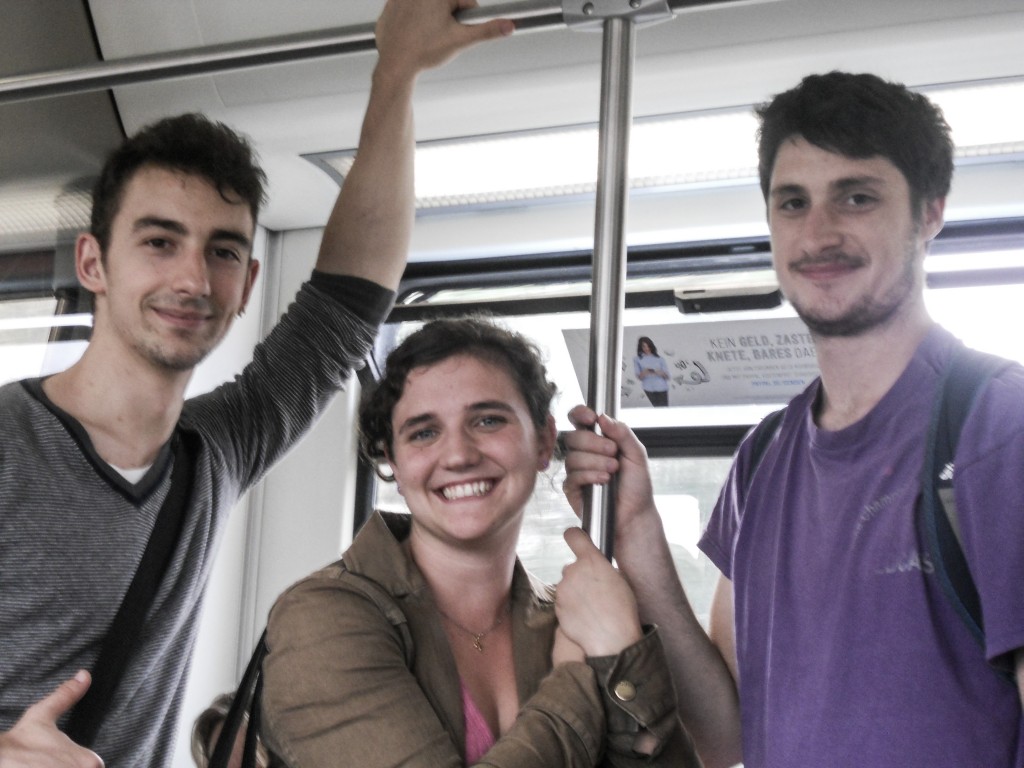Berliner Dom
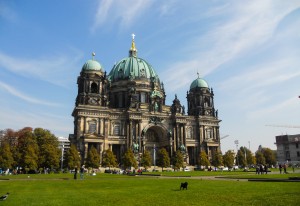 Definitely one of the most beautiful buildings in Berlin (in my opinion), the Dom overlooks a flowing river on one side and the beautiful Lust Garden on the other. The inside of the Dom is ornate and beautiful. The most breathtaking moment, however, is reserved for the view you get when you climb all the stairs, circle the dome, and see Berlin sprawled out before you. >Rachel Schilling ‘16<
Definitely one of the most beautiful buildings in Berlin (in my opinion), the Dom overlooks a flowing river on one side and the beautiful Lust Garden on the other. The inside of the Dom is ornate and beautiful. The most breathtaking moment, however, is reserved for the view you get when you climb all the stairs, circle the dome, and see Berlin sprawled out before you. >Rachel Schilling ‘16<
“Alternative” Street Art Tour
“Alternative” Street Art Tour was extremely interesting. We walked around the city with a local tour guide who explained street art to us from small stencils to giant images that covered entire buildings. We learned about the progression of street art, from tags (which supposedly began in NYC) to graffiti and eventually street art. Some of the works were commissioned and others were illegal. My favorite was the tag for an artist named Po which took the shape of a bum when she learned what Po meant in German.
>Katie Mooradian ‘16<
It was a three hour walking tour through East and West Berlin looking at the different street art and having its meaning explained to us. We saw both legal and illegal street art, both of which cover the buildings in Berlin. Some of the coolest ones were the art pieces showing a deeper meaning, such as the differences still seen between east and west Germans or the limitations that working a white collar job puts on a person. It was very interesting and a great way to see Berlin by foot. >Cassie Blyler ‘16<
Alte Nationalgalerie (Old National Gallery)
I really enjoyed this museum even from the exterior, with the large equestrian statue of Fredrick William the IV. The collections inside were spectacular, ranging from Neoclassical style to Romantic, Impressionist, and early Modernist. I especially enjoyed seeing Romantic artwork in person because it’s actually quite beautiful, but in person I find it a bit kitschy. >Katie Mooradian ‘16<
We visited this museum one morning before the conference and it was really interesting. It is different paintings and sculptures organized by the progression of the different eras of art. My favorite was the room dedicated to Caspar David Friedrich, since in German 210 back at Dickinson we all had to choose one of his paintings and analyze it in terms of Romanticism, so seeing a room full of all his works was really exciting. >Cassie Blyler ‘16<
Pergamon-Museum
During the course of a weekend focused on the very recent past of East Germany and the city that was once divided in half, it felt like entering a different world when Ezra and I visited the Pergamon Museum on the Muse- um Island. This museum, despite being under renovation, still housed three exceptional exhibits. Each of the three exhibits, Antikensammlung (Museum of Classical Antiques), Vorderasiatisches Museum (Museum of the Ancient Near East), and the Museum für Islamische Kunst (Museum of Islamic Art), contained a gigantic structure of some sort that towered over museum goers. Surrounded by the great temples of ancient history, the “piece” that made the biggest impression on me was the Babylonian Processional Way and Ishtar Gate that was salvaged and reconstructed right in the center of the museum. These walls and their gate were reconstructed in the long entrance hall of the museum and is the first piece that museum-goers have a chance to see. While walking through I tried to imagine the Babylonian people that once walked parallel to these very walls.
The rest of the museum left the same impression on me as I walked down the steps of the Market Gate of Miletus and the Mshatta Façade (walls from an eighth-century “castle” in Jordan). The last exhibit we explored was the Museum of Islamic Art. The art itself was beautiful and also educational (for example I learned about the transition from free flowing designs to most pattern and press oriented ones) but the overall concept of the exhibit and appreciation the museum goers had for the art struck more of a chord with me. I feel that in the US there are so many people with stereotypes, negative feelings, or simple ignorance toward Islamic culture and art. I felt fortunate to not only be able to observe the art in front of me but reflect on my own culture after being removed from it. >Rachel Schilling ‘16<
Alexanderplatz
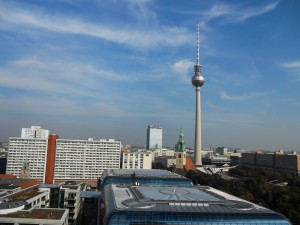 This was the first place in Berlin where I could feel the energy of the city. Live music, literal carnival rides, Trams begging for the opportunity to turn you into a statistic, Döner kebap and Currywurst stands everywhere, and even people bungee jumping off of skyscrapers; it was surreal. Luckily, Alexanderplatz is a main transit junction and I was able to explore this area multiple times. >George DeRosa ‘16<
This was the first place in Berlin where I could feel the energy of the city. Live music, literal carnival rides, Trams begging for the opportunity to turn you into a statistic, Döner kebap and Currywurst stands everywhere, and even people bungee jumping off of skyscrapers; it was surreal. Luckily, Alexanderplatz is a main transit junction and I was able to explore this area multiple times. >George DeRosa ‘16<
Brandenburger Tor
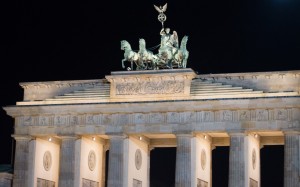 A symbol reminding us of Germany and Europe’s checkered past and also a symbol for peace. It’s very impressive to see at night.
A symbol reminding us of Germany and Europe’s checkered past and also a symbol for peace. It’s very impressive to see at night.
>George DeRosa ‘16<
I went to multiple Flohmärkte (flee markets) and art markets around the city. They were very interesting for what they were, but mostly because of the sheer number of people that were attending them. My favorites were easily the markets on Museum Island. It’s a very good place to buy books if you want to practice your reading in German! >Katie Mooradian ‘16<
The entire trip was filled with poignant moments of history and cultural difference (especially for me, after being raised in a small town). If I had to select a theme, or a feeling, that struck me throughout the weekend, I would choose the very strong difference between Germany’s and America’s history that could be felt throughout the city. It is easy to take for granted over 200 years of consistent and constant govern- ment. Since the creation of the first German empire in 1871 there hasn’t been a regime that has lasted more than about 50 years. The fall of the Wall was only 25 years ago. The reminders of this unrest, as well as the hope for a steadier time, could be found throughout the entire weekend. From the discussions in the conference, to visiting the Berlin Wall and East Side Gallery, to seeing the ancient Babylonian temple in the Pergamon Museum, to celebrating German Re-Unification Day, Berlin serves as a symbol of different pieces being brought together. The old murals on the Berlin Wall are painted with fresh graffiti, old cathedrals look at a giant TV tower built during the time of East Germany and Berlin, and flea markets are filled with used DVDs and old maps from around the world. >Rachel Schilling ‘16<
Berlin is without a doubt one of the “must visit” cities in Europe. It is densely loaded with history, culture, diversity, liveliness and fun. I was particularly attracted to the aesthetic and artistic displays the city, which are like a timeless collage of different styles. Some great examples of this are the graffiti on the streets, the galleries in the open air such as East Side Gallery, the different architectures in the different neighborhoods and especially between the East and the West and the sudden remnants of older periods such as the Berliner Dom. To finish the recipe there are many modern places such as bars, coffee shops, clubs, restaurants and malls all around the city. Berlin is an incredibly mixed city, but it still keeps a bohemian scent to it, for which I think that it really lives up to the “poor, but sexy” slogan that Klaus Wowereit coined in 2004. >Santiago Princ ‘16<


